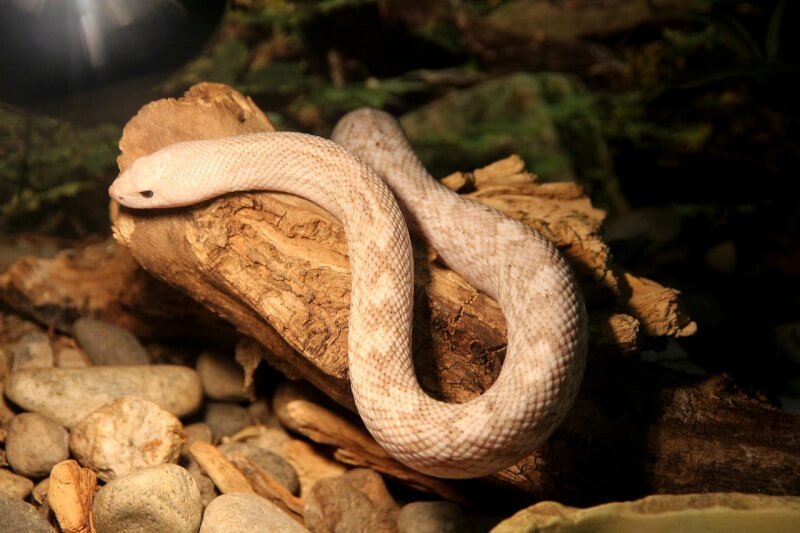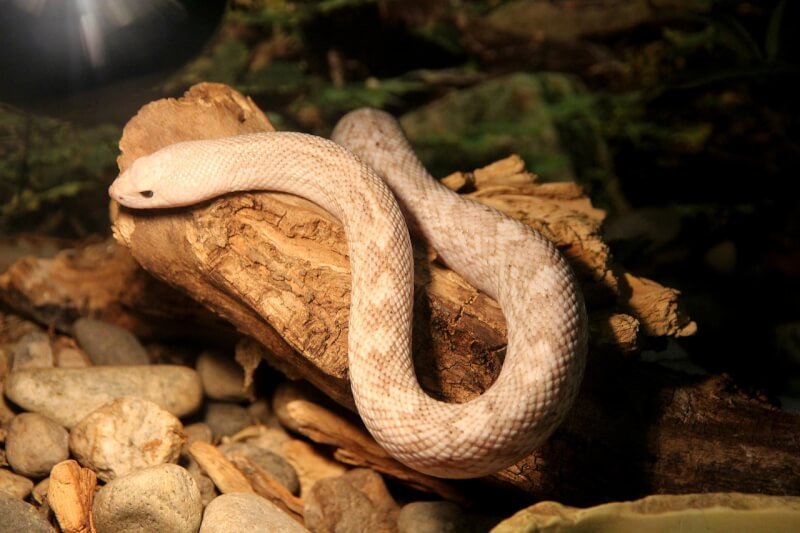If you’re a proud snake owner, one of the key aspects of providing the best care for your scaly friend is ensuring they have the right lighting in their enclosure. The right lighting not only helps to simulate their natural habitat, but it also plays a crucial role in their overall health and well-being. From providing the right temperature gradients to regulating their sleep patterns, understanding the different lighting options available can make a significant difference in your snake’s life. In this article, we will explore the importance of choosing the right lighting for your snake’s enclosure and provide some helpful tips to ensure you create a comfortable and thriving environment for your slithery companion.

Understanding Snake Lighting Needs
When it comes to providing the right lighting for your snake, it’s essential to understand their specific needs. Different snake species have different lighting requirements, and it’s crucial to tailor your lighting setup accordingly for their health and well-being. One of the key factors to consider is whether your snake is a day or night species.
Day vs. Night species
Snakes can be categorized into two broad categories: day species and night species. Day species, as the name suggests, are active during the day and rely on natural sunlight to regulate their internal clocks and stay healthy. Examples of day species include corn snakes, king snakes, and garter snakes.
On the other hand, night species, such as ball pythons and boa constrictors, are more active during the night and are naturally adapted to low light conditions. Providing these nocturnal snakes with bright artificial lights during the night might disrupt their normal behavior and sleep patterns. It’s essential to replicate their natural habitat and provide appropriate lighting conditions.
Lighting requirements for different snake species
Each snake species has its own lighting requirements based on their natural habitat and behavior. Some snakes, like the corn snake, thrive with moderate lighting levels and a natural day-night cycle. Others, like the ball python, may require low-light conditions and a nocturnal lighting setup. It’s crucial to research and understand the specific lighting needs of the snake species you are keeping to ensure their health and happiness.
Natural vs. Artificial Lighting
When it comes to providing lighting for your snake enclosure, you have two options: natural lighting or artificial lighting. Both options come with their benefits and drawbacks, and understanding these can help you make an informed decision for your pet snake’s lighting requirements.
Pros and cons of natural lighting
Natural lighting, particularly sunlight, provides snakes with the full spectrum of light and UVB radiation they need for their overall well-being. Exposure to natural sunlight can promote healthy growth, aid digestion, and support the production of essential vitamins. Additionally, natural sunlight can provide a more visually stimulating environment for your snake.
However, relying solely on natural lighting can be challenging, especially if you live in an area with limited daylight or have a snake that requires specific lighting conditions. Moreover, natural lighting may not penetrate deep into the enclosure, resulting in unevenly distributed lighting. It’s important to supplement with artificial lighting to ensure your snake receives consistent and appropriate lighting.
Pros and cons of artificial lighting
Artificial lighting offers a convenient and reliable solution for providing consistent lighting to your snake’s enclosure. It allows you to control the lighting conditions precisely and mimic the snake’s natural habitat. Artificial lights that emit white light can also provide visual stimulation and enhance the overall appearance of the enclosure.
However, not all artificial lights are created equal. Some may lack the necessary UVB radiation that snakes need for vitamin D synthesis and calcium metabolism. Additionally, certain types of artificial lights, such as bright white LED lights, can disrupt your snake’s day-night cycle if used inappropriately. It’s crucial to select the right type of artificial lighting that meets your snake’s specific requirements.

Types of Lighting for Snakes
There are several types of lighting options available for snake enclosures, each with its own advantages and considerations. Understanding the different types can help you choose the right lighting for your snake.
Incandescent bulbs
Incandescent bulbs are a common choice for providing general lighting and heat to snake enclosures. These bulbs emit a warm glow and can help maintain the ambient temperature in the enclosure. However, they do not emit UVB radiation, which is an essential component for certain snake species.
Fluorescent lights
Fluorescent lights are an excellent option for providing more natural-looking lighting to snake enclosures. They come in different spectrums and can be customized to meet the specific lighting requirements of your snake. Some fluorescent lights also emit a small amount of UVB radiation, which is beneficial for snakes that require it.
Mercury vapor bulbs
Mercury vapor bulbs are a popular choice for snakes that require both heat and UVB radiation. These bulbs emit a broad spectrum of light, including UVB, UVA, and heat. They are efficient and provide a good balance of lighting and heat for a variety of snake species.
Ceramic heat emitters
Ceramic heat emitters are specialized heat sources that do not emit light. They are primarily used to provide supplemental heat in snake enclosures, particularly during the night for nocturnal species. Ceramic heat emitters are a great option when additional heat is needed without interfering with the snake’s lighting requirements.
Choosing the Right Light Bulb
When selecting a light bulb for your snake’s enclosure, it’s essential to consider various factors to ensure it meets their specific lighting needs.
Consider the snake’s natural habitat
Researching the natural habitat of your snake species can give you valuable insights into the type of lighting conditions they require. Consider the sunlight exposure, light spectrum, and UVB intensity in their native environment. This will help you select a light bulb that closely replicates their natural lighting conditions.
Determine the snake’s activity patterns
Understanding whether your snake is diurnal (active during the day) or nocturnal (active during the night) will help you determine the appropriate lighting schedule and intensity. Diurnal snakes may require brighter lighting during the day, while nocturnal snakes may prefer dimmer lights during the night.
Consult with an experienced reptile keeper or veterinarian
If you’re unsure about the specific lighting requirements for your snake, it’s always a good idea to seek advice from experienced reptile keepers or veterinarians. They can provide valuable guidance based on their knowledge and expertise, ensuring you make an informed decision when selecting the right light bulb for your snake’s enclosure.

UVB Lighting for Snakes
UVB lighting is a crucial component of snake lighting setups, especially for species that require it. UVB radiation helps snakes produce vitamin D3, which is essential for calcium metabolism and proper bone development. Here are some important considerations regarding UVB lighting for snakes.
The importance of UVB for snakes
UVB radiation plays a vital role in a snake’s overall health and well-being. It aids in the synthesis of vitamin D3, which is necessary for the proper absorption and utilization of calcium. Snakes deficient in UVB radiation are at risk of developing metabolic bone disease, which can lead to skeletal deformities, weak bones, and overall poor health.
UVB requirements for different snake species
Different snake species have different UVB requirements. Some species, like corn snakes, may not require significant levels of UVB radiation and can obtain sufficient D3 through a well-balanced diet. Other species, such as tropical and desert snakes, require higher levels of UVB radiation to meet their physiological needs. It’s crucial to research your snake’s species-specific requirements to ensure they receive adequate UVB exposure.
UVB bulb options
There are various UVB bulb options available in the market, including fluorescent UVB bulbs and mercury vapor bulbs with UVB capabilities. It’s important to select a UVB bulb that matches the specific requirements of your snake species and provides the appropriate UVB intensity. Consulting with reptile lighting experts or veterinarians can help you make an informed decision in choosing the right UVB bulb for your snake’s enclosure.
Temperature Regulation and Lighting
Proper temperature regulation is essential for the health and well-being of your snake. In reptiles, including snakes, temperature gradients are crucial to allow them to thermoregulate and maintain their metabolic processes effectively. Lighting plays a significant role in creating and maintaining the necessary temperature gradients within your snake’s enclosure.
Maintaining proper temperature gradients
In a snake enclosure, it’s important to have a temperature gradient that allows your snake to move between warmer and cooler areas as needed. The warm side of the enclosure should have a temperature range that allows for digestion and other physiological processes, while the cool side should provide a lower temperature for resting and thermoregulation.
Using heat lamps alongside the primary lighting source
To maintain the proper temperature gradients, it’s common to use heat lamps in conjunction with the primary lighting source. Heat lamps can provide a localized heat source, allowing your snake to bask and raise its body temperature when needed. It’s essential to position the heat lamp and the lighting source to create a suitable gradient, ensuring your snake can comfortably move between the warm and cool areas.
Lighting Schedule for Snakes
Creating a proper lighting schedule is crucial for simulating natural day and night cycles in your snake’s enclosure. Having a consistent lighting schedule helps regulate your snake’s internal clock and promotes regular behavior and a healthy physiological state.
Simulating day and night cycles
Snakes, like many other reptiles, benefit from a simulated day and night cycle in their enclosure. This means providing them with periods of light and darkness that closely mimic their natural habitat. During the day, you can provide a brighter lighting source, while during the night, dimmer lighting or no light at all may be more appropriate.
Proper duration of light exposure
The duration of light exposure also plays a significant role in a snake’s overall health. Daytime lighting should be provided for 10 to 12 hours, while nighttime darkness should be provided for 10 to 14 hours. These durations allow your snake to experience a natural day and night cycle, ensuring they get sufficient rest and maintain their normal behavior patterns.
Lighting Placement in the Enclosure
When it comes to placing lighting in your snake’s enclosure, there are a few key considerations to keep in mind.
Providing multiple light sources
To ensure even lighting distribution and mimic natural sunlight, it’s beneficial to provide multiple light sources throughout the enclosure. This can help prevent shadows and create a more visually stimulating environment for your snake. Placing the lights in different locations, such as above or on the sides of the enclosure, can help simulate sunlight coming from different angles.
Avoiding direct exposure or overheating
While it’s important to provide adequate lighting, it’s equally essential to ensure that your snake is not directly exposed to the light source. Direct exposure to hot bulbs or intense light can lead to discomfort, stress, and even burns. Ensuring that the lights are positioned in a way that prevents direct exposure is crucial for your snake’s well-being.
Considering the snake’s hiding spots
Snakes require hiding spots in their enclosure to feel secure and reduce stress. When placing lighting in the enclosure, it’s important to consider the location of the snake’s hiding spots. Ensure that the lights do not directly illuminate the hiding areas to provide your snake with a sense of privacy and security.
Testing and Monitoring Lighting
Maintaining the right lighting conditions for your snake is an ongoing task that requires regular testing and monitoring.
Using light meters to measure intensity
To ensure that your snake is receiving the appropriate light levels, light meters can be used to measure the intensity of the lighting in your snake’s enclosure. Light meters provide an objective measurement of light intensity, allowing you to make adjustments if necessary. Regularly checking the light intensity can help prevent both insufficient and excessive lighting conditions.
Observing snake behavior and health
Your snake’s behavior and overall health can serve as valuable indicators of whether your lighting setup is appropriate. Pay close attention to your snake’s activity levels, feeding patterns, and shedding behavior. If you notice any significant changes or signs of stress, it might be an indication that adjustments to the lighting conditions are needed.
Regularly checking bulbs for wear and tear
Light bulbs can degrade over time and lose their effectiveness. It’s important to regularly check your light bulbs for wear and tear or any signs of damage. Replace bulbs as needed to ensure that your snake is receiving the appropriate lighting and UVB radiation.
Replacing Light Bulbs
Light bulbs, just like any other electrical device, have a limited lifespan. Regularly replacing your snake’s light bulbs is essential to maintain optimal lighting conditions.
Frequency of bulb replacement
The frequency of light bulb replacement depends on the type of bulb and its expected lifespan. Some bulbs might need to be replaced every six to twelve months, while others can last up to two years. Refer to the manufacturer’s instructions for the specific lifespan of your snake’s light bulbs and make sure to follow the recommended replacement schedule.
Proper disposal of old bulbs
When replacing light bulbs, it’s important to dispose of them properly. Some bulbs, such as compact fluorescent lights (CFLs), contain small amounts of mercury and are considered hazardous waste. Check with your local waste management facility for guidelines on how to safely dispose of old light bulbs. Proper disposal helps protect the environment and prevents potential harm to humans and animals.
In conclusion, understanding and meeting the lighting needs of your snake is essential for their overall health and well-being. Whether it’s providing natural or artificial lighting, choosing the right type of bulb, or simulating day-night cycles, careful consideration and proper monitoring are crucial. By creating an appropriate lighting setup, you can ensure that your snake thrives in their enclosure and enjoys a happy and fulfilling life.


